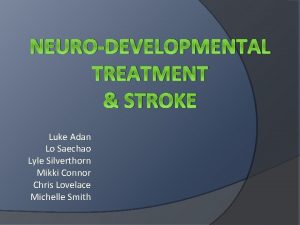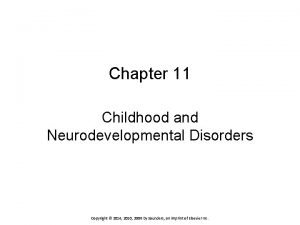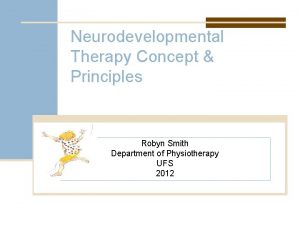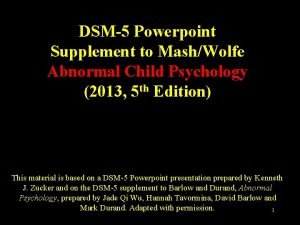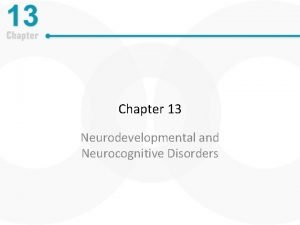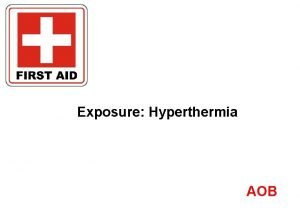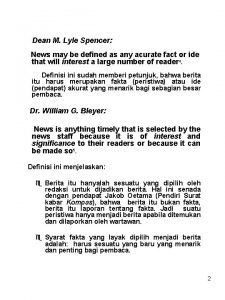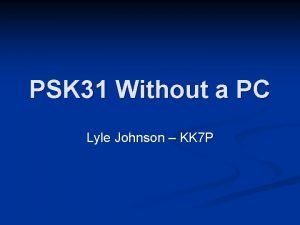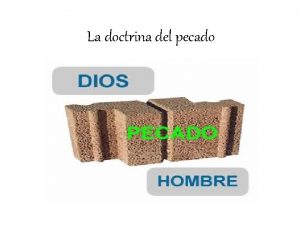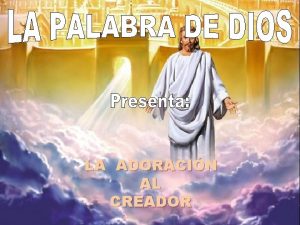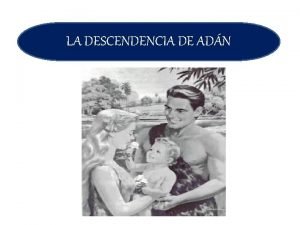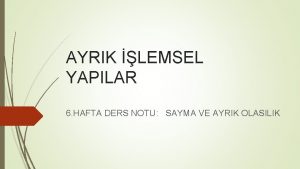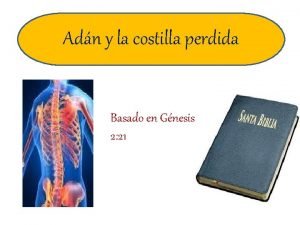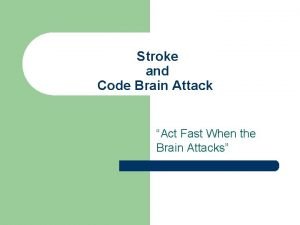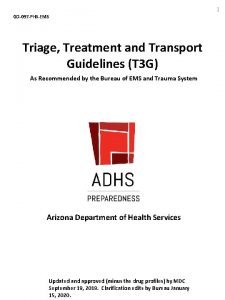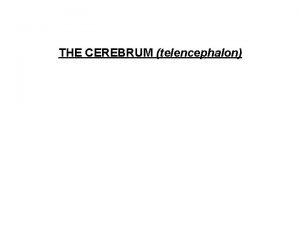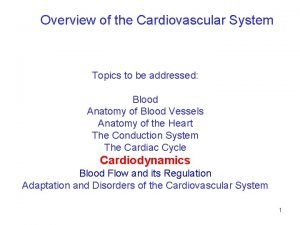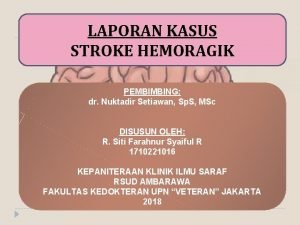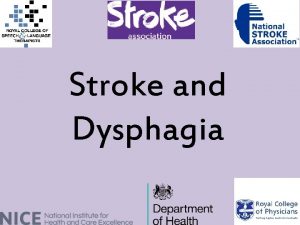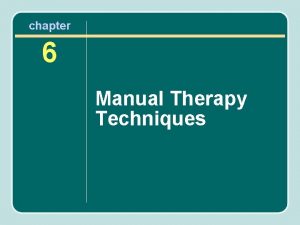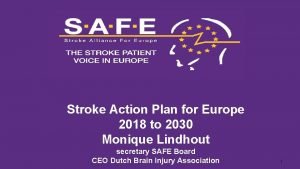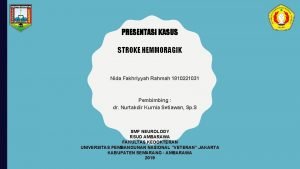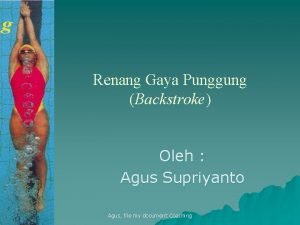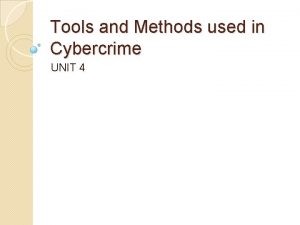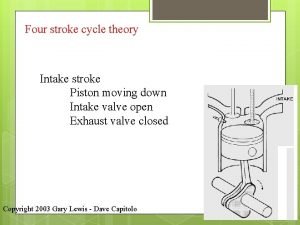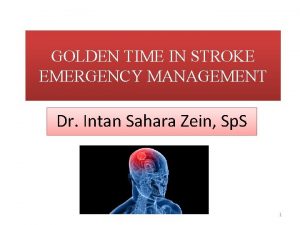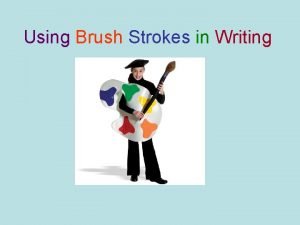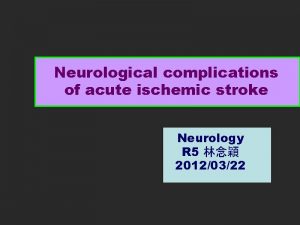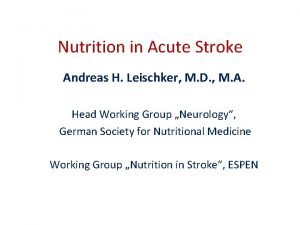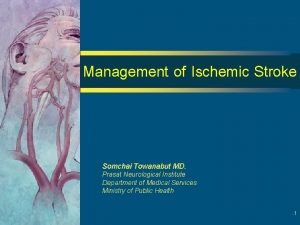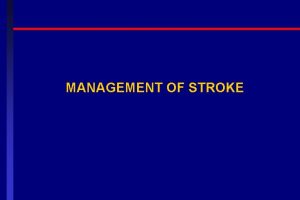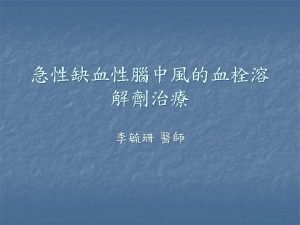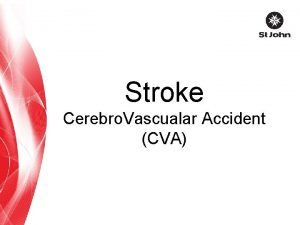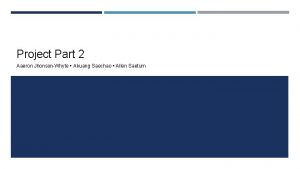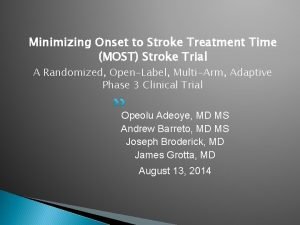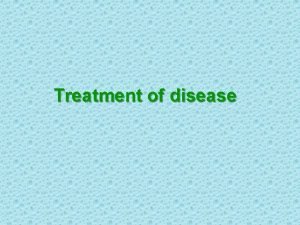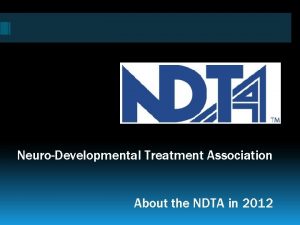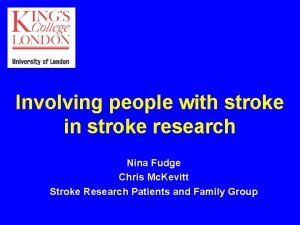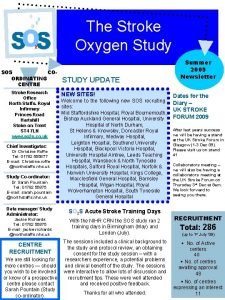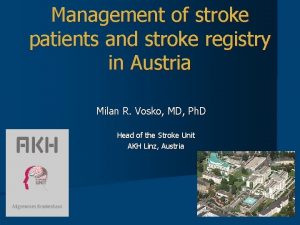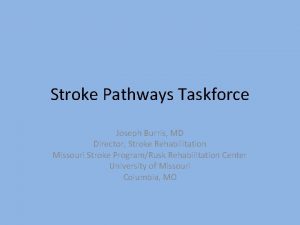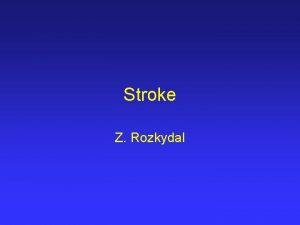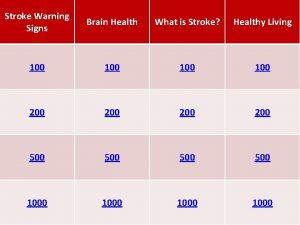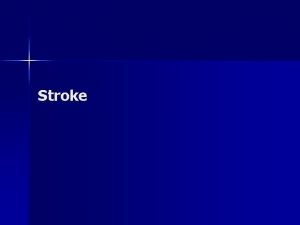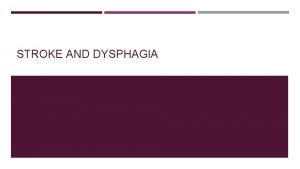NEURODEVELOPMENTAL TREATMENT STROKE Luke Adan Lo Saechao Lyle















































- Slides: 47

NEURO-DEVELOPMENTAL TREATMENT & STROKE Luke Adan Lo Saechao Lyle Silverthorn Mikki Connor Chris Lovelace Michelle Smith

Learning Objectives At the completion of this presentation, the learner will be able to: � Describe the main principles of NDT � Describe early NDT vs. recent NDT � Describe the effectiveness of WSTT vs. NDT for improving gait � Describe how NDT compares to other conventional therapy approaches. � List common problems with reviews of NDT

NDT Background • NDT approach began in the early 1940’s from the work of Mrs. Berta Bobath (Physical therapist) and pediatric neurologist Dr. Karel Bobath (Psychiatrist/Neurophysiologist). • Based on their experience of working with children with CP and adults with hemiplegia • Observations were based on the Reflex/Hierarchical model

NDT and Adult Hemiplegia Main problems in patients with UMN lesions: � Abnormal coordination � Abnormal postural tone Thus, aims should be: � Introduction of more selective movement patterns in preparation for functional skills � Reduction of spasticity Bobath, 1990

Early NDT Bobath originally believed in reflex inhibiting postures (RIPs) � Placed and held patients in RIPs to break up the abnormal postural and movement patterns. � Believed this would change the activity of the whole body due to the “normalization” of postural tone. � No spontaneous carry over into movement and function occurred. � Treatment was too static and was not continued in this way Bobath, 1990

Revised NDT Theory: Dynamic “autoinhibition” by using reflex inhibiting movements � As patient moves, PT prevents the unwanted parts of the abnormal movement by using “key points of control” �Particularly proximal joints � PT should gradually withdraw control as the movement continues Bobath, 1990

NDT Main Principles � It is impossible to superimpose normal movement patterns on abnormal ones, so abnormal patterns need to be inhibited � Movement is a sensory-motor experience: We do not learn a movement but the “sensation of a movement” � By moving the proximal part of the body it is possible to influence and change movements of the distal parts Bobath, 1990

Evolution of NDT Principles � NDT in North America is currently based on an interactive complex systems model � Problems in tone, posture, balance, and movement are equally important in producing atypical synergies that interfere with functional activities. � NDT recognizes that it is essential to evaluate measurable changes in functions as well as changes in motor and body systems that support those functions. Neuro-Developmental Treatment Association, 2007

Evolution of NDT Principles Original Core Concepts Still Applicable � Bobath’s therapeutic handling techniques make normal posture/movements more easy/likely to occur � Bobath’s focus on the interaction of impairments, function, and life participation (expanded to ICF) � Bobath’s focus on taking a “holistic” approach to treating patients Neuro-Developmental Treatment Association, 2007

NDT in the Clinic Therapeutic handling allows therapist to: Feel the client’s response to changes in posture or movement � Fascilitate postural control and movement synergies that broaden the client’s options for selecting successful actions � Provide boundries for movements that distract from the goal � Inhibit or constrain those motor patterns that, if practiced, lead to secondary deformities, further disability, or decreased participation in society � Howle , 2002

WEIGHT SUPPORTED TREADMILL TRAINING VS. NDT Treadmill Training With Partial Body Weight Support Compared With Physiotherapy in Nonambulatory Hemiparetic Patients Heese, S. et al. Stroke. 1995; 26: 976 -981

Purpose � Compare the efficiency of PT based on NDT vs. WSTT in gait training for post stroke chronic hemi paretic patients. Heese et al. 1995

Participants � 7 nonambulatory hemiparetic patients � 52 to 72 years old Heese et al. 1995

Methods � A-B-A single case study design � 3 phases were administered to the participants � 1 st phase= WSTT � 2 nd phase= NDT � 3 rd phase= WSTT Heese et al. 1995

Results-Functional Ambulation Category Heese et al. 1995

Results-Rivermead Motor Assessment Heese et al. 1995

Results-gait velocity Heese et al. 1995

Conclusion (Big Picture) � WSTT is… is superior to NDT because WSTT �Task oriented exercise � More independent �Higher dosage Heese et al. 1995

Thaut, Leins et al. Rhythmic Auditory Stimulation Improves Gait More Than NDT/Bobath Training in Near-Ambulatory Patients Early Poststroke: A single. Blind, Randomized Trial. Neurorehabil Neural Repair 2007; 21: 455

Subjects � 155 hemiparetic patients were randomly selected to (RAS group or NDT group). � Age: 69 ± 11 Thaut et al. 2007

Methods RAS - metronome and music tapes NDT – Bobath principles Major gait parameters measured: velocity, stride length, cadence, and swing symmetry. Heese et al. 1995

Results Heese et al. 1995

Conclusion (Big Picture) According to this study RAS is superior to NDT because… �RAS gives the pt. an external cue to regulate parameters of gait. It only works when its on. When off only a few minutes will transfer. Heese et al. 1995

Paci, M. PHYSIOTHERAPY BASED ON THE BOBATH CONCEPT FOR ADULTS WITH POST-STROKE HEMIPLEGIA: A REVIEW OF EFFECTIVENESS STUDIES. J Rehabil Med 2003; 35: 2– 7 � Systematic Review of 15 trials out of 726 � 6 RCTs, 6 CTs, 3 Case Series � No level 1 studies due to small sample size or weak evidence from Pvalue � Age range 15 -95 years “NDT is the most widely used approach in the rehabilitation of hemiparetic subjects in Europe, and it is well known and frequently used in many countries, including the USA, Canada, Japan, Australia and Israel” Purpose: � Is there evidence that NDT is effective? � Is NDT more effective than other treatments for adults with hemiplegia?

NDT Vs. EMG Feedback � No difference found in all outcome measures Upper Limb � EMG activity � Upper Extremity Function Test � Finger Oscillation Test � Health Belief Survey � Mood and Affect Tests Lower Limb � EMG activity � ROM � Gait analysis Basmajian et al, 2003 Mulder et al. , 1986

NDT Vs. Traditional Functional Retraining General Rx � NDT group improved more on Barthel Index than TFR � No significant difference in all measures �Functional Independence Measure (FIM) �Box & Block Test �Nine-hole Peg Test Salter et al. , Gelber et al. , Lewis, 2003

NDT vs. Brunnstrom General Rx � No significant difference in all outcome measures �Action Reach Arm Test �Barthel Index �Gait speed Wagenaar et al. , 2003

NDT Vs. Motor Relearning Programme General Rx � MRP group improved more in: �Barthel Index �Motor Assessment Scale �Sodring Motor Evaluation Scale � No difference found in �Nottingham Health Profile Langhammer et al. , 2003

NDT Vs. Forced Use Upper Limb � Forced Use group had more improvements than NDT in Action Reach Arm Test (dexterity) � No difference in all other outcome measures �Rehabilitation Activities Profile �Fugl-Meyer �Motor Activity Log Van der Lee et al. , 2003

Conclusion � No evidence supporting NDT as the optimal type of treatment. � Important to note: �So even though NDT may NOT be superior, it does positively effect recovery �There was a significant improvement in most of the measured parameters for the NDT groups, but the improvements weren’t significantly different than other treatments Paci, 2003

Hiraoka, K. Rehabilitation Effort to Improve Upper Extremity Function in Post-Stroke Patients: A Meta-Analysis. J Phys Ther Sci. 2001(13), 5 -9. Studies ranged between 1966 - 1999 14 trials reviewed All RCTs Interval Since Stroke 0 days to 8 years Length of Treatment 2 to 50 weeks Sample Size 20 to 282 people

Methods � Interventions Assessed � NDT vs. Conventional PT � Conventional PT vs. No Rx � EMG biofeedback vs. Conventional PT � EMG biofeedback vs. No Rx � Upper extremity function assessed by: � Rivermead Motor Assessment Arm Scale, � Action Reach Arm Test, � Fugl-Meyer Assessment, � Upper Extremity Functional Test, � Frenchay Arm Test. Hiraoka, 2001

Results � Used Cohen’s criteria to determine effect size - Large effect (significant difference) = ≥ 0. 8 - Medium effect (difference) = 0. 5 – 0. 8 - Small effect (no difference) = 0. 2 – 0. 5 � Interventions Assessed � NDT vs. Conventional PT: effect size = (0. 01) � Conventional PT vs. No Rx: effect size = 0. 51 � EMG biofeedback vs. Conventional PT = 0. 75 � EMG biofeedback vs. No Rx = 0. 85

Conclusion � The effects of NDT and conventional treatment are almost identical � EMG Feedback had a larger effect on improving UE function in post stroke patients than NDT or conventional PT Hiraoka, 2001

Yelnik, A. et al. Rehabilitation of Balance After Stroke With Multisensorial Training: A Single-Blind Randomized Controlled Study. Neurorehabil Neural Repair 2008; 22: 468 Objective: § Compare 2 physical rehabilitation approaches to restore balance after recent stroke: NDT vs Multisensorial Training Methods: § 68 patients who were able to walk without human assistance § 3 to 15 months post first stroke § Received NDT or Mulitisensorial Rx for 20 sessions in 4 weeks Sample Size § NDT = 35 patients § Multisensorial = 33 patients

Outcome Measures Standing balance § Berg Balance Scale Dynamic balance § Assessed during walking by percentage of double-limb stance time Daily Independence § Functional Independence Measurement (FIM) Quality of Life § Nottingham Health Profile Yelnik et al. , 2008

Assessment Differences between groups on Day 30 § No difference between groups Differences between groups on Day 90 § Both the NDT and Multisensorial approach showed significant improvements in all outcome measures compared to baseline measures, but the Multisensorial approach showed more improvement. § However, the differences between-groups were of no statistical significance Yelnik et al. , 2008

Conclusion No significant differences between NDT and Multisensorial Training § No evidence that one approach is superior to the other § Yelnik, A. et al

Kollen, B. J. et al. The Effectiveness of the Bobath Concept in Stroke Rehabilibation: What is the Evidence? Stroke (Journal of the American Heart Association). 2009(40), e 89 -e 97. � 16 trials reviewed �Sample size: 813 patients total (21 -120 in individual studies) �Inclusion criteria: ○ Involvement of adult patients with a cerebrovascular accident ○ The effects of the Bobath Concept were compared with those of an alternative method ○ Randomized, controlled clinical trial (RCT) ○ Only English or Dutch publications were considered for inclusion.

� Inclusion Criteria (Cont. ) �Rehab outcomes were measured in one or more of the following: ○ Sensorimotor function of the upper and/or lower ○ ○ ○ extremity Balance control Mobility (The ability to (re)position the body by transfer or gait) Dexterity (Reaching, grasping, fine hand use) Activities of Daily living (ADLs) Health-Related Quality of Life (HRQOL) Cost effectiveness Boudewijn et al. 2009

Results � There was no evidence of the superiority of NDT for sensorimotor control of the upper and lower limb, dexterity, mobility, ADLs, HRQOL, and cost-effectiveness � Only limited evidence was found to support the superiority of NDT for balance Boudewijn et al. 2009

Common Problems with reviews of NDT � Little homogeneity between studies �Stage of stroke recovery �Treatment interval �Age of patients �Outcome measures �Treatment comparison � Failure to clarify exact methods used

Why Do We Use NDT? � Personal Experience of the Therapist � Authority � Evidence Based Practice �NDT works, but not better or worse than other methods �If you are going to put your hands on a patient NDT is a good intervention to use

� HOWEVER, today there is good evidence to support other interventions: �CIMT �BWSTT �Task-Specific Training �Mental Imagery WE NEED TO BE EDUCATORS IN THE CLINIC!

Learning Objectives At the completion of this presentation, the learner will be able to: � Describe the main principles of NDT � Describe early NDT vs. recent NDT � Describe the effectiveness of WSTT vs. NDT for improving gait � Describe how NDT compares to other conventional therapy approaches. � List common problems with reviews of NDT

Works Cited Bobath, B. (1990). Adult Hemiplegia: Evaluation and Treatment, 3 rd Edition. Oxford: Heinemann Medical Books. Foley, N. et Al. Upper Extremity Interventions. Evidence-Based Review of Stroke Rehabilitation. 2009; 1 -109. Hesse, S. et. al. (1995). Treadmill Training with Partial Body Weight Support Compraed With Physiotherapy in Nonambulatory Hemiparetic Patients. Stroke. 26: 976 -981. Hiraoka, K. Rehabilitation Effort to Improve Upper Extremity Function in Post-Stroke Patients: A Meta-Analysis. J Phys Ther Sci. 2001(13), 5 -9. Howle, J. M. (2007). NDT in the United States: Changes in Theory Advance Clinical Practice. Retrieved April 2009 from www. ndta. org Howle, J. M. (2002). Neuro-Developmental Treatment Approach: Theoretical Foundations and Principles of Clinical Practice. Neuro-Developmental Treatment Association. Kollen, B. J. et al. (2009). The Effectiveness of the Bobath Concept in Stroke Rehabilibation: What is the Evidence? Stroke (Journal of the American Heart Association); 40: e 89 -e 97.

Works Cited Lennon, S. & Ashburn, A. (2000). The Bobath concept in stroke rehabilitation: a focus group study of the experienced physiotherapists’ perspective. Disability and Rehabilitation, 22 (5): 665 -674. Paci, M. Physiotherapy based on the bobath concept for adults with post-stroke hemiplegia: a review of effectiveness studies. J Rehabil Med 2003; 35: 2– 7. Thaut, M. H. et al, (2007). Rhythmic Auditory Stimulation Improved Gait More that NDT/Bobath Training in Near-Ambulatory Patients Early Poststroke: A Single-Blind, Randomized Trial. Meurorehabil. Neural. Repair; 21: 455 -459 Yelnik, A. et al, (2008). Rehabilitation of Balance After Stroke With Multisensorial Training: A Single-Blind Randomized Controlled Study. Neurorehabil Neural Repair; 22: 468
 Reflex inhibiting patterns
Reflex inhibiting patterns Anterior stroke vs posterior stroke
Anterior stroke vs posterior stroke Chapter 11 childhood and neurodevelopmental disorders
Chapter 11 childhood and neurodevelopmental disorders Neurodevelopmental disorders
Neurodevelopmental disorders Neurodevelopmental therapy principles
Neurodevelopmental therapy principles Childhood disorders dsm-5 ppt
Childhood disorders dsm-5 ppt Neurocognitive and neurodevelopmental disorders
Neurocognitive and neurodevelopmental disorders Heat stroke treatment
Heat stroke treatment Lyle alzado cause of death
Lyle alzado cause of death Masplas
Masplas M. lyle spencer
M. lyle spencer Lyle c may death row
Lyle c may death row James lyle johnson
James lyle johnson James lyle md
James lyle md Alice porter murray
Alice porter murray Tyte&lyle
Tyte&lyle Por el pecado de un hombre entro la muerte
Por el pecado de un hombre entro la muerte Que señal de obediencia dio dios a adan y eva
Que señal de obediencia dio dios a adan y eva Anagrama de dinamoelectrico
Anagrama de dinamoelectrico Doctrina del pecado
Doctrina del pecado Como era la serpiente antes de ser maldecida por dios
Como era la serpiente antes de ser maldecida por dios Estatura de adan y eva
Estatura de adan y eva Descendientes de adan y eva hasta jesus
Descendientes de adan y eva hasta jesus Adan başla saymaya
Adan başla saymaya The adam and eve family tree
The adam and eve family tree Juan tamad
Juan tamad La costilla se regenera
La costilla se regenera Code fast stroke
Code fast stroke Blood thinners names
Blood thinners names Basal ganglia stroke
Basal ganglia stroke Cardiac output definition
Cardiac output definition Diagnosis topis stroke
Diagnosis topis stroke Nice dysphagia
Nice dysphagia J stroke myofascial release
J stroke myofascial release Stroke action plan
Stroke action plan End-diastolic volume vs end-systolic volume
End-diastolic volume vs end-systolic volume Bentuk kepala normocephal artinya
Bentuk kepala normocephal artinya Apa yang dimaksud dengan back crawl stroke
Apa yang dimaksud dengan back crawl stroke Anaerobic gaspak
Anaerobic gaspak Aca territory stroke
Aca territory stroke Key stroke logger
Key stroke logger Intake stroke piston movement
Intake stroke piston movement Anamnesis
Anamnesis Absolute brush stroke
Absolute brush stroke Partes del stick de floorball
Partes del stick de floorball Recurrent stroke causes
Recurrent stroke causes Guideline clinical nutrition in patients with stroke
Guideline clinical nutrition in patients with stroke Differential diagnosis of stroke
Differential diagnosis of stroke
